FIRST LOOK: Propellerhead Software Record
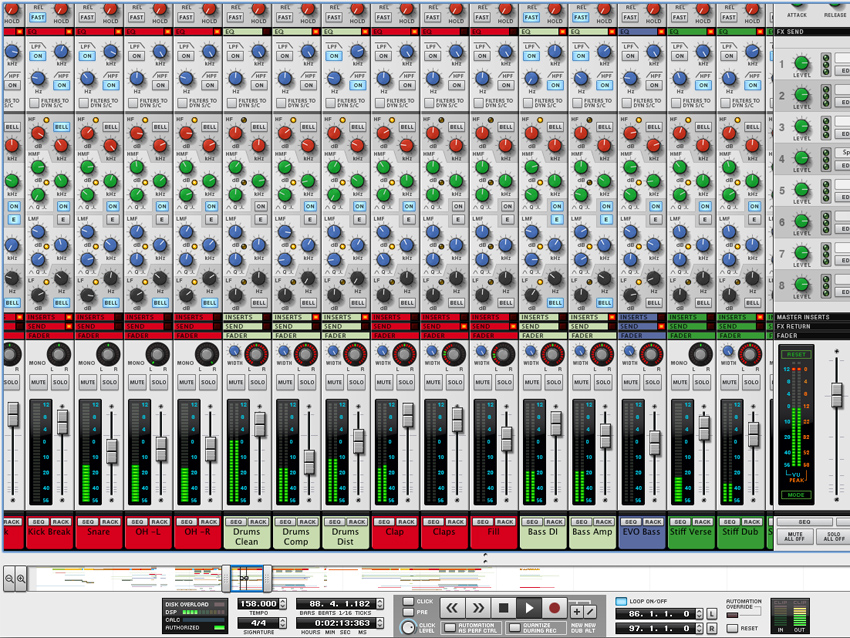
It's fair to say that Propellerhead Software has had an enormous influence on music production as we now know it. It started with ReCycle, which transformed the art of loop sampling. Rebirth and Rebirth 2 soon followed, arguably defining the modern concept of vintage emulation in software.
Then came the real revolution: Reason. Admittedly basic at first, it had two things that made it stand out from the typical DAW/host paradigm. First, it closely recreated the visual aspects of the technology it emulated, which not only looked cool, but made it clear to the computer music novice exactly what was going on, teaching them a lot about music technology in general.
Second, it was entirely self-contained, helping to make it so efficient that it could run on even the most modest of machines.
These two basic principles have seen Reason go from strength to strength, maintaining its status as one of the most ubiquitous and popular music-making tools ever made. There is, however, one criticism that gets levelled at Reason time and again: it can't record audio. Want to add some vocals? You'll have to load them into a sampler. Want guitars? You'll have to load them into a sampler.
Audio options
This fact alone has relegated Reason to the role of compositional sketchpad for many of its devoted users. Numerous suggestions have been made on how to integrate this facility, ranging from simple audio tracks running in parallel (not very Propellerhead) to virtual ADAT machines (you'd need to be of a certain age to remember these multitrack digital recorders), but ultimately none of them were close to what Propellerhead eventually elected to do.
"Rather than bring us 'Reason 5 Audio', Propellerhead has brought us a whole new application: Record."
Rather than bring us 'Reason 5 Audio', it's brought us a whole new application: Record. Instead of just bolting linear audio recording functionality onto Reason, those crafty Swedes have taken a look at everything good and - in their opinion - bad that's happened to hard-disk recording over the last ten years or so, and created a streamlined package from the ground up. Oh, and they've made sure it integrates absolutely seamlessly with Reason.
We've been exploring the beta version for a few weeks now, and it's fair to say that we're salivating in anticipation of the September 9, 2009 release date. You'll have to hang on for our review of the finished thing to find out if it's truly a must-buy, but read on to find out what we make of it so far.
Want all the hottest music and gear news, reviews, deals, features and more, direct to your inbox? Sign up here.
Overview
Propellerhead describes Record as recording software for musicians, as opposed to recording professionals, and this ethos shines through from start to finish. Efficiency and ease are the buzzwords, and this is clear from the moment you fire it up.
Not only that, but Propellerhead's applications have always had a reputation for stability, and even at this beta stage, it already has a piece of software that's more stable than many of the finished products we've tried over the years.
The program itself revolves around three main views (there's a combined view for single-screen operation, too), which you can navigate easily using hot keys. The keyboard shortcuts are a welcome and much more common theme throughout Record than they are in Reason.
"The mixer is as gob-smacking as a right hook from Optimus Prime."
The first screen is a rather familiar-looking arrangement page. Any Reason user will be immediately at home with the layout but will also notice a few enhanced features, such as fast navigation tabs at the bottom and side, showing a complete overview and enabling you to jump to any track or section of the arrangement instantly, even if it isn't shown in the main view. It all feels like an effective and sophisticated evolution of Reason, with 'new' features for Record including a revised output level meter and extra buttons in the transport.
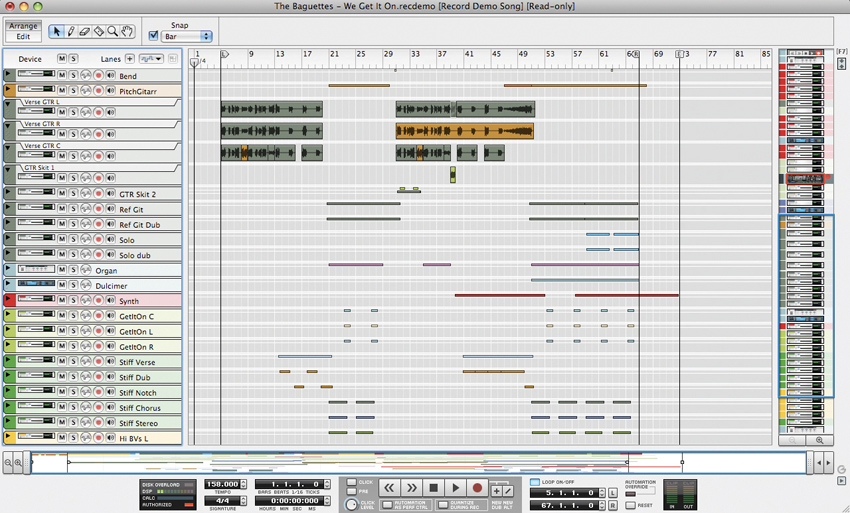
The next window is the mixer, which we'll look at more closely later on, but suffice to say that it's as gob-smacking as a right hook from Optimus Prime. Finally, there's the rack window, which will also be familiar to anybody who's ever used Reason - think of it simply as a virtual recreation of an old-school studio rack, which contains all of the audio devices, sub-mixers and instruments used in your project.
One of the best things about Record is proper multi-screen support. Unlike Reason, you can now resize all of the windows, including the rack (which also permits multiple adjacent racks, so you no longer have to scroll through every unit from top to bottom when navigating it), so that they fill up the available display space. We spread the app out across three monitors and it made Reason's constrained layout feel maddeningly slow to negotiate in comparison.
In use
Record is designed to be used quickly, so recording really is as easy as creating a track (with one command) and, well… recording! It's about as simple a system as you'll come across.
Once you've recorded a few takes, you can compile the best bits using one of the best comping systems ever devised. Double-click the recording and it opens in an editor showing all the passes stacked up vertically, enabling you to choose which sections to use to make up the final track, completely non-destructively and complete with fades if required.
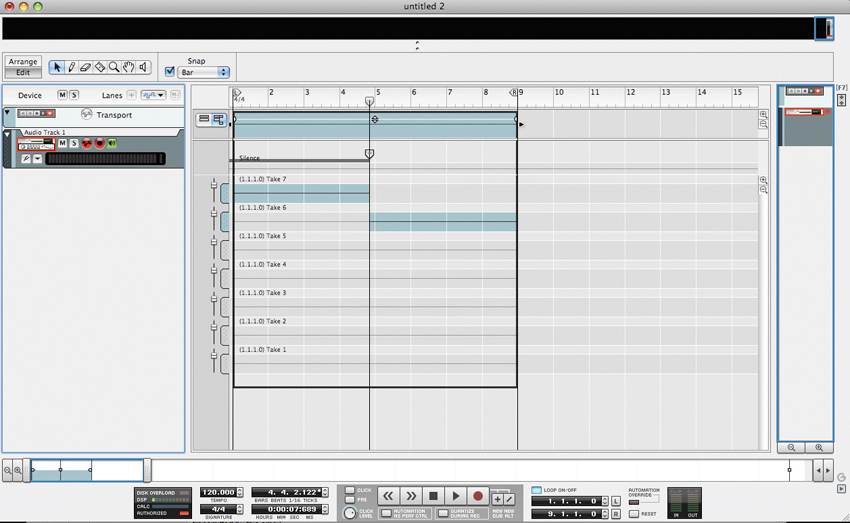
This isn't the most impressive thing about recording in Record, though - that accolade must go to the incredible timestretching. Utilising Propellerhead's own new algorithm, Record lets you change the tempo of the project non-destructively in real time, at any point, over a truly remarkable range. In terms of sound quality and low-artifact performance, the algorithm is as good as anything we've ever heard.
"Even Ableton Live users are going to be floored by Record's timestretching."
Even Ableton Live users are going to be floored by this aspect of Record and just how far you can take it from the original tempo without damaging the sound.
As well as enabling you to completely change the vibe of your track at any point in its production, this stellar timestretching performance also means that Record could quickly become the go-to software for professional remixers, as there's currently no faster or better-sounding way to try out your remix parts at different tempos than to load them up in Record.
The software also excels when it comes to project management. Similar to Reason's self-contained system, every single external sound you bring into Record gets included within the project file, so if you're collaborating on a project, you need never worry about any missing files. And all are preserved in their original state within the saved project - all conversion is done by the software in real time.
What if your collaborator just wants stems (grouped audio exports), though, rather than the actual Record project? Not a problem, as Record offers a superb stem export facility, making it supremely easy to bounce either all your tracks or just the ones you want via a straightforward checkbox screen.
Devices
Record comes as standard with many of the devices you'll find in Reason: the MClass series, RV7000 reverb, Scream 4 distortion, DDL-1 delay and CF-101 are all here, along with utility devices like the Spider splitter modules. And if you've got Reason installed, then you have access to all of its instruments and effects.
There are several all-new devices that are specific to Record, such as Audio Track devices that give you routing capabilities that allow for sidechain inputs and signal routing, while the Mixer Track devices handle inserts for your main mixer channels.
"Record's two new 'headline' devices are really rather awesome: emulations of Line 6's Guitar Pod and Bass Pod."
The ID8 device, meanwhile, gives non-Reason owners a selection of MIDI instrumentation for compositional purposes (Record has MIDI tracks with an integrated piano roll), with a usable bank of generic drum and instrument sounds for putting together basic backing tracks, much like the General MIDI sound modules of old.

Record's two new 'headline' devices are really rather awesome: emulations of Line 6's Guitar Pod and Bass Pod. Anybody who's used these industry-standard amp/cab modelling units will know just what a coup this is. As well as the range of amp and cab combinations that these two offer on their own, existing Line 6 USB-model owners can attach their hardware to their computer and use the presets in their hardware from the comfort of the Record interface. Now that's seamless hardware integration if ever we've seen it.
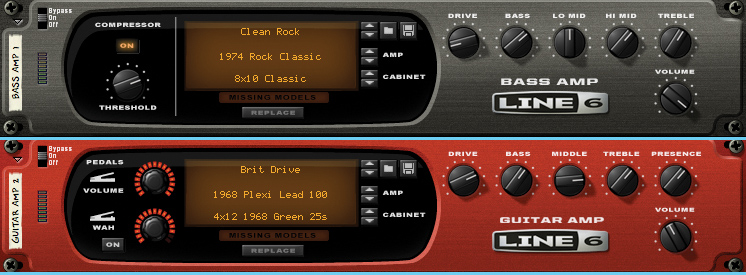
The mixer
That's most of the major stuff covered, but we still need to tell you about the one feature that's perhaps most surprising of all and has had everybody in the industry raising an eyebrow: that SSL 9000k-modelled analogue mixing desk.
Remarkably, it lives up to its lofty promise. The 9000k channel strip has been emulated, from EQ and compression to inserts and routing. It really is outstanding and even includes the much-coveted SSL Mix Bus Compressor.
To have a visual recreation of the layout of one of the most revered desks in the history of recording is all very well, but it sounds the part, too. We can envision people exporting stems from their regular DAW and running them through Record's virtual SSL just to get 'that' sound - it's a beautiful thing. And of course, being virtual, the mixer is only as complicated as you need it to be, so if you only have 18 channels in your project, you only have 18 channels showing.
Reason integration
Clearly, one of the most important aspects of Record is its total integration with Reason, ie, there's no ReWire or complex routing required. If you already have a registered copy of Reason 4 installed on your system (Propellerhead assure us that for stability reasons, it's only compatible with v4), then when you install Record, all of Reason's devices, features and capabilities are made available within it, right down to its mixers (quaint as they now seem!) and ReGroove system.
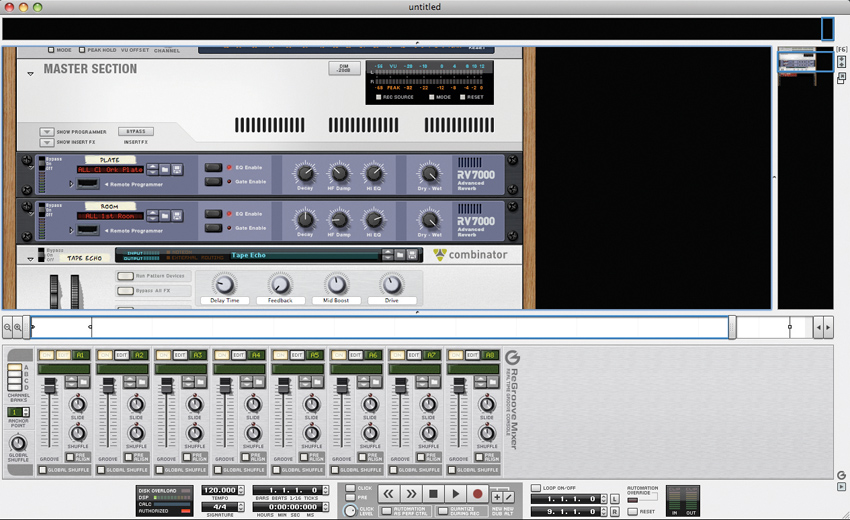
The importance of this can't be overstated, as while Record clearly offers plenty of mixing sophistication, to ensure complete compatibility, you need to be able to open your entire Reason 4 projects, all of which rely on mixers within the rack, as opposed to Record's new separate mixer stage.
And not only that, it ensures that one of Reason's key features, namely its versatility, is preserved. Reason's user-definable routing makes it stand out from most mainstream music apps, and Record offers this too, except that now it has the bonus of a virtual SSL control room bolted on.
If you don't have Reason, there is still the ID8 device for basic backing tracks. However, based on the announced upgrade packages for Reason 4 owners, you might be tempted to snap up Reason now and get to grips with it while you're waiting for Record!
It almost goes without saying that Record can ReWire up to 64 channels of audio into any ReWire master application (Propellerhead state that they wouldn't have got anywhere near this level of power, stability and efficiency if they'd made Record itself a ReWire master), and that it has full support for two-way integration with MIDI control hardware.
Key or no key?
Even Record's authorisation process comes with a little dose of Propellerhead ingenuity. Existing Reason users will probably panic at the sight of a USB dongle, but it's by no means the whole story.
You can run Record in three modes, and with the USB Ignition key attached, there are no restrictions whatsoever. But what if you're working on your laptop with limited ports, or you're travelling and don't want to take your precious dongle with you? Or you've broken it and are waiting for a replacement? Well, you have two other choices.
Firstly, you can use Internet Verification, which enables you to unlock the software for the session (ie, every time you run it) by typing in your Propellerhead account details (assuming you've registered Record, of course). The second option is to run in demo mode. But this is no ordinary demo mode, as it offers 100% functionality - right down to recording, saving and exporting. In fact, the only thing you can't do in demo mode is open saved projects.
"Existing Reason users will probably panic at the sight of a USB dongle, but it's by no means the whole story."
So using this launch option, you could be using a friend's machine in the middle of a field and still be able to work with Record, taking the project back to your Ignition Key/internet-equipped workstation to finish it off.
Looking good
And that's your lot! As you'll no doubt have sensed, we're rather excited about Record. It takes all the friendliness, power, simplicity, versatility, ingenuity and stability of Reason and couples that with audio recording, multicore processing, a stunning mixer, some brilliant interface touches and an overall approach that is wonderfully 'Propellerhead'. Registered Reason users who haven't signed up to try the beta yet really should.
Needless to say, we'll be bringing you our review of the final release version as soon as we can get our hands on it. Unless something goes very wrong between now and then, we're in for a real treat this September.



Computer Music magazine is the world’s best selling publication dedicated solely to making great music with your Mac or PC computer. Each issue it brings its lucky readers the best in cutting-edge tutorials, need-to-know, expert software reviews and even all the tools you actually need to make great music today, courtesy of our legendary CM Plugin Suite.
